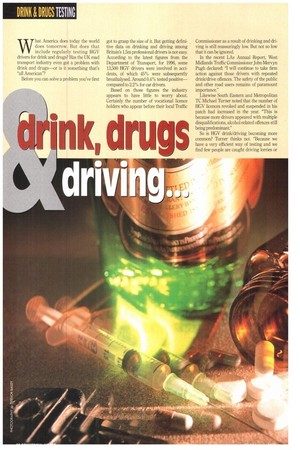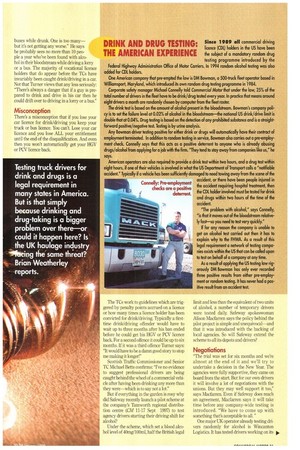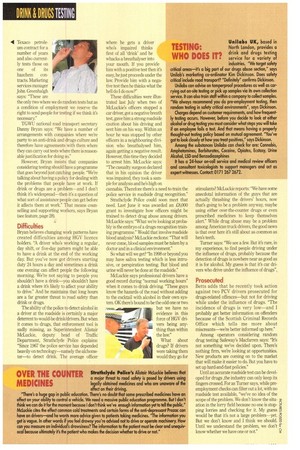DRINK & DRICS TEN
Page 32

Page 33

Page 34

If you've noticed an error in this article please click here to report it so we can fix it.
What America does today the world does tomorrow. But does that include regularly testing HGV drivers for drink and drugs? Has the UK road transport industry even got a problem with drink and drugs—or is it something that's "all American"?
Before you can solve a problem you've first got to grasp the size of it. But getting definifive data on drinking and driving among Britain's 1.5m professional drivers is not easy. According to the latest figures from the Department of Transport, for 1996, some 13,500 HGV drivers were involved in accidents, of which 45% were subsequently breathalysed_ Around 0.4% tested positive— compared to 22% for car drivers.
Based on those figures the industry appears to have little to worry about_ Certainly the number of vocational licence holders who appear before their local Traffic Commissioner as a result of drinking and driving is still reassuringly low. But not so low that it can be ignored.
In the recent LAs Annual Report, West Midlands Traffic Commissioner John Mervyn Pugh declared: "1 will continue to take firm action against those drivers with repeated drink/drive offences. The safety of the public and other road users remains of paramount importance."
Likewise South Eastern and Metropolitan TC Michael Turner noted that the number of HGV licences revoked and suspended in his patch had increased in the year. "This is because more drivers appeared with multiple disqualifications, alcohol-related offences still being predominant."
So is HGV drink/driving becoming more common? Turner thinks not. "Because we have a very efficient way of testing and we find few people are caught driving lorries or
buses while drunk. One is too many—
but it's not getting any worse." He says he probably sees no more than 10 peo ple a year who've been found with alco hol in their bloodstream while driving a lorry or a bus. The majority of vocational licence holders that do appear before the TCs have invariably been caught drink/driving in a car. Not that Turner views that any less seriously: "There's always a danger that if a guy is prepared to drink and drive in his car then he could drift over to driving in a lorry or a bus."
Misconception
There's a misconception that if you lose your car licence for drink/driving you keep your truck or bus licence. You can't. Lose your car licence and you lose ALL your entitlement until the end of the disqualification. And even then you won't automatically get your HGV or PCV licence back. The TCs work to guidelines which are triggered by penalty points accrued on a licence or how many times a licence holder has been convicted for drink/driving. Typically a firsttime drink/driving offender would have to wait up to three months after his ban ended before he could get his EIGV or PCV licence back. For a second offence it could be up to six months. If it was a third offence Turner says: "It would have to be a damn good story to stop me making it longer!"
Scottish Traffic Commissioner and Senior TC Michael Betts confirms: "I've no evidence to suggest professional drivers are being caught behind the wheel of a commercial vehicle after having been drinking any more than they were—which is to say not a lot"
But if everything in the garden is rosy why did Safeway recently launch a pilot scheme at the company's Tamworth regional distribution centre (CM 11-17 Sept 1997) to test agency drivers starting their driving shift for alcohol?
Under the scheme, which set a blood alcohol level of 40111g/100ml, half the British legal
limit and less than the equivalent of two units of alcohol, a number of temporary drivers were tested daily. Safeway spokeswoman Alison Macfarren says the policy behind the pilot project is simple and unequivocal—and that it was introduced with the backing of local agencies. So will Safeway extend the scheme to all its depots and drivers?
Negotiations
"The trial was set for six months and we're almost at the end of it and we'll try to undertake a decision in the New Year. The agencies were fully supportive, they came on board from the start. But for our own drivers it will involve a lot of negotiations with the unions. But they may well support it too," says Macfarren. Even if Safeway does reach an agreement, Macfarren says it will take time before any company-wide testing is introduced. "We have to come up with something that's acceptable to all."
One major UK operator already testing drivers randomly for alcohol is Wincanton Logistics. It has tested drivers working on its Texaco petroleum contract for a number of years and also currently tests those on one of its hazchem contracts. Marketing
services manager John Greenhalgh says: "These are the only two where we do random tests but as a condition of employment we reserve the right to send people for testing if we think it necessary."
TGWU national road transport secretary Danny Bryan says: "We have a number of arrangements with companies where we're party to an anti-drink and drugs culture and therefore have agreements with them where they can carry out tests where there is reasonable justification for doing so."
However, Bryan insists that companies considering testing should have a programme that goes beyond just catching people. "We're talking about having a policy for dealing with the problems that people have at work. If
drink or drugs are a problem and I don't think it's widespread then it's a question of
what sort of assistance people can get before it affects them at work." That means counselling and supporting workers, says Bryan (see feature, page 28).
Difficulties Bryan believes changing work patterns have created difficulties among HGV licence holders. "A driver who's working a regular. day shift, or five-day pattern might be able to have a drink at the end of the working day, But you've now got drivers starting duty 24 hours a day and sometimes a drink one evening can affect people the following morning. We're not saying to people you shouldn't have a drink—you shouldn't have a drink where it's likely to affect your ability to drive." And he maintains that long hours are a far greater threat to road safety than drink or drugs.
The ability of the police to detect alcohol in a driver at the roadside is certainly a major deterrent to would-be drink/drivers. But when it comes to drugs, that enforcement tool is sadly missing, as Superintendent Alistair McLuckie, deputy head of Traffic Department, Strathclyde Police explains: "Since 1967 the police service has depended heavily on technology—namely the alchome. ter—to detect drink. The average officer where he gets a driver who's impaired thinks first of all 'drink' and he whacks a breathalyser into your mouth. If you provide him with a positive test then it's easy, he just proceeds under the law. Provide him with a negative test then he thinks what the hell do I do now?"
These difficulties were illustrated last July when two of McLuckie's officers stopped a air driver got a negative breath test, gave him a strong roadside caution about his driving and sent him on his way. Within an hour he was stopped by other officers in a neighbouring division who breathalysed him, ag-din getting a negative result. However, this time they decided to arrest him. McLuckie says: "The casualty surgeon declared that in his opinion the driver was impaired, they took a sample for analysis and he's high on cannabis. Therefore there's a need to train the police service in roadside drug recognition."
Strathclyde Police could soon meet that need. Last June it was awarded an £8,000 grant to investigate how officers might be trained to detect drug abuse among drivers. McLuckie says: "What we're looking at probably is the embryo of a drugs recognition training programme." Would that involve roadside blood analysis? McLuckie reckons: "That will never come, blood samples must be taken by a doctor and in a clinical environment."
So what will we get? "In 1998 or beyond you may have saliva testing which is less intrusive, or perspiration testing. But blood and urine will never be done at the roadside."
McLuckie says professional drivers have a good record during "normal working hours" when it comes to drink driving. "These guys know the hazards of the road without adding to the cocktail with alcohol in their own system. OK there's bound to be the odd one or two but we have no evidence in this force of HGV drivers being anything than within the law" What about drugs? If drivers were taking them would they go for
stimulants? McLuckie reports: "We have some anecdotal information of the guys that are actually thrashing the drivers' hours, now that's going to be a problem anyway, maybe using either over-the-counter drugs or even prescribed medicines to keep themselves alert." While drug abuse may be a problem among American truck drivers, the good news is that over here it's still about as common as hen's teeth.
Turner says: "We see a few. But it's rare, in my experience, to find people driving under the influence of drugs, probably because the detection of drugs is nowhere near as good as it is for alcohol. My guess is that it's car drivers who drive under the influence of drugs",
Prosecuted
Betts adds that he recently took action against two PCV drivers prosecuted for drugs-related offences—but not for driving while under the influence of drugs. "The incidence of drugs is very low—and I probably get better information on offenders because of the Scottish Criminal Records Office which tells me more about miscreants—we're better informed up here."
Among operators considering random drug testing Safeway's Macfarren says: "It's not something we've decided upon. There's nothing firm, we're looking at opportunities. New products are coming on to the market that will make it easier to do. But you have to set up hard-and-fast policies."
Until an accurate roadside test can be developed for drugs ,the industry can only keep its fingers crossed. For as Turner says, while preemployment checks can filter out a lot, with no roadside test available, "we've no idea of the scope of the problem. We don't know the situation in the lorry field because no one is stopg ping lorries and checking for it, My guess would be that it's not a large problem—yet. ,■1 But we don't know and I think we should. 5' Until we understand the problem, we don't know whether we have one or not."
DRINK AND DRUG TESTING: THE AMERICAN EXPERIENCE
Since 1989 all commercial driving licence CD) holders in the US have been the subject of a mandatory random drug testing programme introduced by the
Federal Highway Administration Office of Motor Carriers. In 1994 random alcohol testing was also added for CM. holders.
One American company that pre-empted the law is DM Bowman, a 500-truck fleet operator based in Williamsport, Maryland, which introduced its own random drug testing programme in 1984.
Corporate safety manager Michael Connelly told Commercial Motor that under the law, 25% of the total number of drivers in the fleet hove to be drink/drug tested every year. In practice that means around eight drivers a month are randomly chosen by computer from the fleet roster.
The drink test is based on the amount of alcohol present in the bloodstream. Bowman's company policy is to set the failure level at 0.02% of alcohol in the bloodstream—the national US drink/drive limit is double that at 0,04%. Drug testing is based on the detection of any prohibited substance and is a straightforward positive/negative test. Testing is by urine analysis.
Any Bowman driver testing positive for either drink or drugs will automatically have their contract of employment terminated, In addition to random testing in service, Bowman also carries out a pre-employment check. Connelly says that this acts as a positive deterrent to anyone who is already abusing drugs/alcohol from applying for a job with the firm. "They tend to stay away from companies like us," he says.
American operators are also required to provide a drink test within two hours, and a drug test within eight hours, if one of their vehicles is involved in what the US Department of Transport calls a "notifiable accident," Typically lie vehicle has been sufficiently damaged to need towing away from the scene of the accident, or there have been people injured in the accident requiring hospital treatment, then the CDL holder involved must be tested for drink and drugs within two hours of the time of the accident. 11.1111t Connelly: Pre-employment
checks are a positive s) . deterrent. "The problem with alcohol," says Connelly, "is that it moves out of the bloodstream relatively fast—so you need to test very quickly."
If for any reason the company is unable to get an alcohol test carried out then it has to explain why to the FHWA. As a result of this legal requirement a network of testing companies exists within the US that can be called upon to test on behalf of a company at any time.
As a result of applying the US testing law rigorously DM Bowman has only ever recorded three positive results from either pre-employmentor random testing. It has never had a positive result from an accident test.
TESTING: WHO DOES IT?
Unilabs UK, based in North London, provides a
drink and drugs testing service for a variety of industries. "We target safety critical areas—it's a big part of our drugs abuse section," says Unilab's marketing co-ordinator Kim Dickinson. Does safety critical include road transport? "Definitely" confirms Dickinson. Unilabs can advise on tamperproof procedures as well as carrying out on-site testing or pick up samples via its own collection service. It can also train staff within a company to collect samples. "We always recommend you do pre-employment testing, then random testing in safety critical environments", says Dickinson. Charges depend on customer requirements, and how frequently testing occurs. However, before you decide to look at either alcohol or drug testing you must consider what steps you will take if an employee fails a test. And that means having a properly thought-out testing policy based on mutual agreement. "You've got to look closely at how you treat positives," says Dickinson.
Among the substances Unilabs can check for are: Cannabis, Amphetamines, Barbiturates, Cocaine, Opiates, Ecstasy, Urine Alcohol, L5D and Benzodiazephines
It has a 24-hour on-call service and medical review officers and consultant toxicologists to support managers and act as expert witnesses. Contact 0171 267 2672.
OVER THE COUNTER MEDICINES
Strathclyde Police's Alistair Mcluckie believes that a major threat to road safety is posed by drivers using legally obtained medicines and who are unaware of the effect on their driving. "There's a huge gap in public education. There's no doubt that some prescribed medicines have an effect on your ability to control a vehicle. We need a massive public education programme. But I don't think we can do it for the moment because I don't think we've enough information yet to tell the public." McLuckie cites the effect common cold treatments and certain forms of the anti-depressant Prozac can have on drivers—and he wants more advice given to patients taking medicines. "The information you get is vague. In other words if you feel drowsy you're advised not to drive or operate machinery. How can you measure an individual's drowsiness? The information to the patient must be clear and unequivocal because ultimately it's the patient who makes the decision whether to drive or not."






































































































